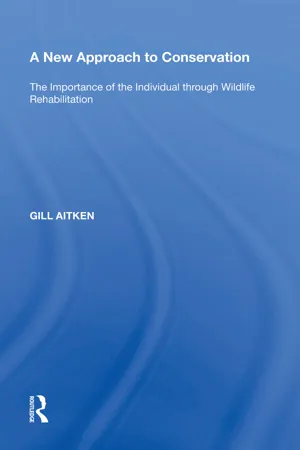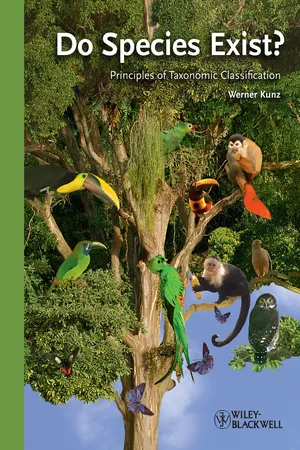Biological Sciences
Reproductive Isolation
Reproductive isolation refers to the mechanisms that prevent interbreeding between different species or populations. These mechanisms can be prezygotic, occurring before fertilization, or postzygotic, occurring after fertilization. Reproductive isolation is a key factor in the process of speciation.
Written by Perlego with AI-assistance
Related key terms
4 Key excerpts on "Reproductive Isolation"
- eBook - ePub
- Andrew Hendry(Author)
- 2016(Publication Date)
- Princeton University Press(Publisher)
increased through an opposing reproductive “enhancer” (Hendry 2009). For example, colorful low-predation male guppies moving downstream over waterfalls into high-predation sites, where resident males are drab, might have lower survival (barrier: Weese et al. 2011) but higher mating success (enhancer: Schwartz and Hendry 2006, Labonne and Hendry 2010). Third, reproductive barriers are often assessed in artificial situations, such as the laboratory, and thus might not accurately reflect isolation in nature. For example, assortative mate choice in stickleback can be evident in the lab (McKinnon et al. 2004) but not in mesocosms or in nature (Jones et al. 2006, 2008). Fourth, reproductive barriers/enhancers are often asymmetric, constraining gene flow from one group into another while sometimes enhancing it in the reverse direction (Ellers and Boggs 2003, Forister 2004, Räsänen and Hendry 2014).For all of the above reasons, the best studies examine multiple potential barriers in multiple populations in multiple ecological and geographical contexts (e.g., McKinnon and Rundle 2002, Nosil 2007, Jiggins 2008, Lowry et al. 2008b), and yet additional reproductive barriers and contexts could be considered in all natural systems. Given this necessary limitation, it is useful to focus first on barriers that would act early in a potential introgression event, such as habitat preference, selection against migrants, and temporal isolation. The reason is that later-acting barriers can only reduce gene flow that remains following early acting barriers—and meta-analyses have shown that early acting barriers do much of the job in ecological speciation (Coyne and Orr 2004, Nosil et al. 2005, Lowry et al. 2008a, Schemske 2010). In addition, it is good practice to combine “integrated measures of ecological speciation” with the reproductive barrier approach.Ecological speciation in natureEcological differences have been thought to promote speciation ever since Darwin (1859), and this recognition was an important part of the modern synthesis (Dobzhansky 1940, Simpson 1944, 1953b, Lack 1947, Mayr 1947, 1963). However, it wasn’t until the last 20 years or so that the field really took off with the formal exposition of the ecological theory of adaptive radiation and the role of ecological speciation therein (Schluter 2000a, Coyne and Orr 2004, Rundle and Nosil 2005, Nosil 2012). At present, evolutionary biologists don’t question the fact that divergent selection can cause adaptive divergence which can contribute to the evolution of Reproductive Isolation. Yet many open questions remain that we can here consider, such as (Q1) how often is speciation ecological? (Q2) how often do ecological differences cause speciation? (Q3) how fast is ecological speciation? and (Q4) how “fragile” (prone to collapse) is it? Other topics address potential contributors to ecological speciation, including the importance of (Q5) competition within and among species, (Q6) “reinforcement” of mating preferences to avoid maladaptive between-type mating, (Q7) “magic” traits that are both under divergent selection and promote Reproductive Isolation, (Q8) the dimensionality (number of independent axes) of selection and adaptation, and (Q9) sexual selection that might promote or constrain mating isolation. As usual, I will address these questions by reference to meta-analyses whenever possible; otherwise I will provide key examples and speculate on their possible generality. - eBook - ePub
A New Approach to Conservation
The Importance of the Individual through Wildlife Rehabilitation
- Gill Aitken(Author)
- 2018(Publication Date)
- Routledge(Publisher)
the process that produces variety, where that variety is most usefully – but in no way rigidly – delineated by 'species'. Biological variety or diversity may not be able to be pinned down – either by the category 'species' or indeed by any other category – but this does not make such variety any the less important. What it does do is to shift the focus of concern away from the end-product and towards the process that produces this variety-namely, the process of speciation. At first glance, then, there may have appeared to be a contradiction between the de-emphasis of 'species' and the promotion of 'speciation' but this worry is unfounded.If one of the dangers of overvaluing the species is undervaluing the process, then we ought to be clearer as to what, exactly, this process that begets biological diversity is, and how it is to be valued. Various isolating mechanisms lie beneath the formation of diverse biological forms. The great majority of these are prezygotic barriers that 'impede mating between species or hinder fertilization of ova should members of different species attempt to mate' (Campbell, 1987, p. 463). Prezygotic isolating mechanisms include ecological, temporal, behavioural, mechanical and gametic isolation. There are postzygotic barriers, too, that prevent hybridisation between some species. But what is significant is that the great majority of these isolating mechanisms are expressions of differential adaptations to the environment.To illustrate this let us look at an example used by E. O. Wilson: the giant silkworm moths of North America. They 'fly and mate at various times during late afternoon and through the night' the females releasing a powerful chemical scent to attract the males. Each of the 69 species, Wilson explains, 'has its own heure d'amour' and '[f]ew if any mistakes are made thanks to the combination of timing and scent' (p. 51-52). It is this adaptive isolation that prevents the majority of species from hybridising, and leads Wilson to say that '[t]he wonder is not that hybridization fails but that it ever works' (p. 50). The significant point is that it is the particular kind of interaction between organisms that brings about and sustains biological diversity. As Wilson puts it:the differences between species ordinarily originate as traits that adapt them to the environment, not as devices for Reproductive Isolation. The adaptations may also serve as intrinsic isolating mechanisms, but the result is accidental. Speciation is a by-product of vertical evolution (p. 53, emphasis removed). - eBook - ePub
- David Baum, Douglas Futuyma, Hopi Hoekstra, Richard Lenski, Allen Moore, Cahterine Peichel, Dolph Schluter, Michael Whitlock(Authors)
- 2013(Publication Date)
- Princeton University Press(Publisher)
Another very important point to keep in mind when studying speciation is that Reproductive Isolation driven and maintained by ecological natural selection can collapse when environmental conditions change. A classic example of such species collapse involves cichlid fish in Lake Victoria, Africa—species that occur at different depths. The gradient of light quality correlated with depth has driven evolutionary changes in a light-absorbing opsin gene. It is thought that the local adaptation of female light perception to light at different depths has in turn led to changes in their preference for male coloration. Males of fish in shallow water, where blue wavelengths of light are abundant, have evolved blue coloration. Males occurring in deeper water, where available light is shifted to the red end of the visible light spectrum, are colored red. Under normal clear-water conditions, assortative mating occurs within deep and shallow populations because female cichlids prefer males that have the most visible colors. The recent introduction of anthropogenic pollution to the lake changed the way light passes to different water depths. This altered visibility has led to interbreeding followed by the collapse of closely related species. Eric B. Taylor, Janette W. Boughman, and others recently documented a similar collapse of deep- and shallow-water stickleback ecotypes in Enos Lake, British Columbia. In that case, changes to the lake caused by the introduction of a foreign crayfish apparently led to a breakdown of assortative mating. Thus, while ecological barriers are thought to evolve quickly during the process of speciation, they may not be sufficient to maintain species boundaries into the future.Finally, it is challenging to infer whether divergent populations and ecotypes will ever become distinct species. It is clear from decades of research that not all adaptations within a species are necessarily involved in speciation. A major goal of speciation research is to determine why some adaptations are important to the process of speciation while other adaptations segregate within species without leading to appreciable Reproductive Isolation.4. REINFORCEMENTReinforcement - eBook - ePub
Do Species Exist?
Principles of Taxonomic Classification
- Werner Kunz(Author)
- 2013(Publication Date)
- Wiley-Blackwell(Publisher)
These examples again make Mayr's concept of the species as a reproductive community questionable. If all of the individuals that are putatively cross-fertile with each other would belong to a common species, the Mallard and Pacific Black Duck as well as the American Ruddy Duck and Old World White-headed Ruddy Duck definitely would have to be considered as being conspecific. However, this action has not been taken; they can be found as different species in every bird identification book.6.25 The Origin of Reproductive Isolation Through Reinforcement
Yet not in all cases does the encounter of allopatrically separated species carry the danger of the hybridogenic disappearance of a species. In an encounter of previously allopatrically separated species, there are two possibilities: Either the two species blend, which because of the dominance of one species almost always leads to the termination of the other species, or there are barriers, which keep the blending contained or entirely prevent it. If species are allopatrically separated, then it is not foreseeable which of the two possibilities will take place if the two species encounter each other again.If two populations are allopatrically separated, then there is no selective pressure to evolve any type of species barrier. Prezygotic or postzygotic genetic incompatibilities only arise by chance. The emergence of both types of barriers is not promoted under allopatric conditions because there is no biological need for them; the individuals do not encounter each other anyway. Under allopatric separation postzygotic genetic incompatibilities usually have a higher chance to emerge than prezygotic incompatibilities, because they are not as specific as premating or fertilization barriers.This line of reasoning has a remarkable consequence. If two allopatrically separated populations secondarily come together in the course of the immigration of one population into the domicile of the other population, then postzygotic mating barriers could exist, but no prezygotic mating barriers would exist. As a consequence, the two populations mate with each other. However, because of postzygotic genetic incompatibilities, the offspring of such mating is reduced in vitality and fertility. This effect is a significant disadvantage in the fitness of the parents that produce such hybrids because their reproduction will not be very successful. This outcome leads to a selective pressure that promotes the expression of genes for prezygotic incompatibility, for example aversion between the different sexual partners. This scenario then prevents mixed matings. Assortative mating has then evolved.
Learn about this page
Index pages curate the most relevant extracts from our library of academic textbooks. They’ve been created using an in-house natural language model (NLM), each adding context and meaning to key research topics.



